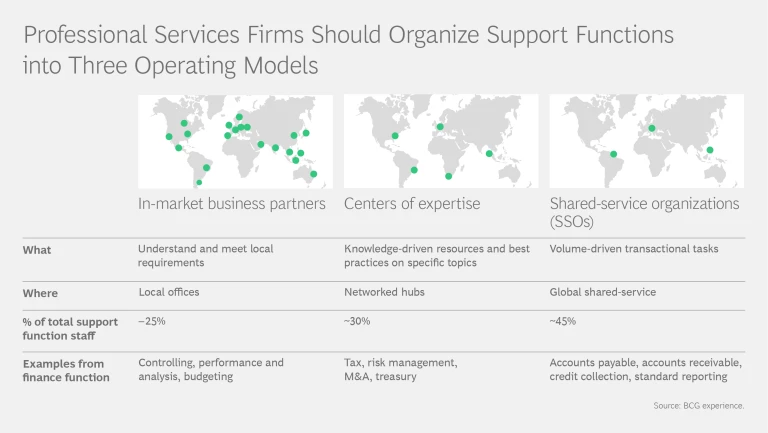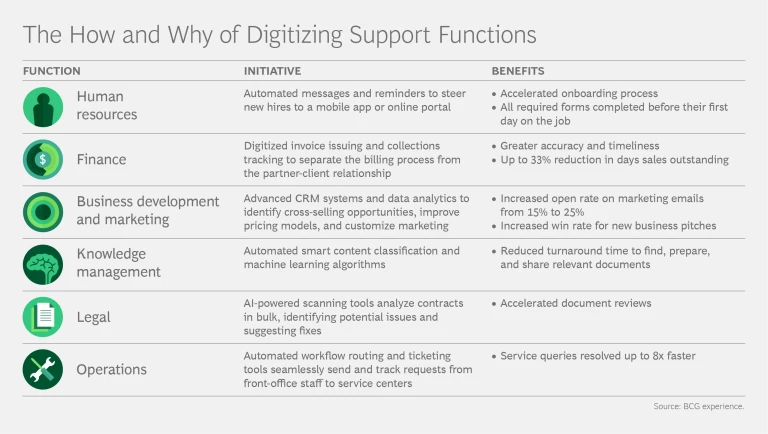Professional services companies need not accept the status quo for their support functions: rising costs, declining profit margins, and low satisfaction among internal customers. By using digital technologies such as automation and artificial intelligence to improve the productivity of their support functions, professional services firms can achieve cost savings of 30% to 40% and accelerate their commercial engine.
At professional services firms, functional costs are outpacing revenues, and companies in law, accounting, consulting, and similar fields are feeling the strain of declining profit margins. From 2014 to 2018, BCG analysis showed that annual revenue growth barely exceeded 2% at a representative sample of top global professional services firms. Over the same time period, BCG found that general & administration (G&A) costs within this same sample of professional services firms grew more than 10 times faster—increasing at an impressive CAGR of 25%.
Yet even as they spend more on their support functions, companies aren’t getting any more bang for their buck. BCG’s research and experience shows that internal customers are increasingly dissatisfied with the service they receive from various support functions including IT, HR, finance and accounting, business development, marketing, customer service, knowledge management, procurement, facilities, and real estate services.
Why are internal customers so unhappy? One big problem is that most multinational professional-services firms have evolved into complex matrixed structures organized across multiple dimensions—geographies, industries, and practices. Frequently, each one of these dimensions has its own support functions, causing inefficiency. And that leaves the fee-earning employees to cope with a huge overlap and duplication of work between local and global levels of support functions.
Fragmentation within support functions also prevents professional services organizations from achieving the financial benefits associated with economies of scale.
“Sometimes, I don’t know who to contact within our support function team. The system is extremely difficult to navigate,” lamented one professional services client.
Underinvestment in Digitization Hurts Quality, Reduces Speed, and Limits Capabilities
Overall, professional services firms have been so focused on top-line growth that they have reacted to many of their problems with their support functions simply by increasing staffing. And they have failed to invest in digital capabilities that could accelerate commercial growth. That’s because it is far easier to “throw people at a problem” than to rework processes and implement new technologies.
Offshoring
To add personnel to support functions while trying to control costs, professional services firms have generally leaned on low-cost offshoring solutions—which don’t usually rely on digital tools or enhanced end-to-end processes. And so savings on personnel in some of these offshore locations have been offset by quality-control problems that have hurt the bottom line. For example, one client discovered that billing inaccuracies and mistakes that originated in an offshore support center led to revenue leakage of up to £100 million.
IT
When it comes to their IT budgets, most professional services firms are underinvesting in the next-generation technologies that they require to expand and transform their businesses. In comparison to some other industries, professional services firms spend less of their IT budgets on next-generation technologies like advanced systems for CRM, contract management automation, or AI-enabled recruiting tools.
Morale
Employees working in support functions at professional services firms know that many of their colleagues see them solely as a cost center that processes transactions, rather than as a source of competitive advantage. They recognize that they do not have a seat at the table in the C-suite to discuss how they could help advance the success of the company.
Given such underinvestment in automation technology and in advanced people capabilities, many personnel working in support functions at professional services firms are stuck performing repetitive manual processes and have few opportunities for personal development. This causes low morale, which itself leads to high turnover rates. At one professional services client, the annual attrition rate among global support function staff reached 20%.
A Three-Point Approach to Digitizing Support Functions
Professional services firms do not need to accept the support function status quo of rising costs, declining profit margins, and low satisfaction among fee-earning internal customers.
By using digital technologies such as automation and artificial intelligence (AI) to improve the productivity of their support functions, our research and experience shows that professional services firms can achieve cost savings of 30% to 40%.
As the digitized support function becomes faster and more accurate, it will free client-facing partners and teams from wasting time on administrative tasks. By redirecting this time to client service, these teams can generate additional revenue.
To digitize their support functions, professional services firms can take three mutually reinforcing actions.
1. Create a Streamlined Operating Model for Support Functions
In 2018, BCG surveyed senior executives at more than 30 multinational professional services firms. The study found that more than 90% believed that having a streamlined operating model for support functions is crucial to providing a unified client experience, harmonizing their practices and services, and capturing the benefits of digitization.
Yet only 10% of those executives reported having actually digitized their support functions on an end-to-end basis.
The fact is that most professional services firms still have fragmented, duplicative support functions that cause dissatisfaction and confusion among fee-earners and clients. It would be futile to attempt to digitize these inefficient systems.
To capture the benefits of digitization, professional services firms must first simplify and standardize the operating model for their support functions. The ideal operating model optimizes allocation of support function resources across three types of roles.
A single, unified operating model allows all support-function personnel to work cohesively together with well-defined role clarity. The model provides revenue-generating employees clear points of contact with the support teams. For any type of query or task, fee-earners will know exactly where to go and whom to contact to get what they need.
To fully realize the benefits of an operating model, the organization must fully commit to assigning resources, budgets, and decision rights on a global level.
2. Standardize Support Function Services and Processes
As professional services firms grow—especially if they grow through mergers and acquisitions—they tend to develop a decentralized structure with multiple legacy systems. These systems are often incompatible, making it hard for members of the firm to collaborate. Consequently, data can fall through the cracks during hand-offs from one system to another.
To facilitate communication among these various systems, firms rely on heavy customization and lots of manual labor—up to three times more workers than a modern digitized support function.
Firms using multiple legacy systems not only incur higher labor costs, they also miss out on economies of scale and find it difficult to compare and evaluate the performance of support function personnel.
The Value Liberated by Standardization. Professional services firms can cut through these problems by developing globally standardized end-to-end processes that leverage technology to support collaboration and good governance. These standard global processes allow professional services firms to achieve economies of scale and lower costs by automating many transactional tasks. This automation liberates the most talented support function personnel to focus on higher value-added activities and become true in-market business partners.
To ensure accountability for the effectiveness and efficiency of these processes, firms should designate a global process owner (GPO) for each core end-to-end process. This person functions like a chief operating officer for the process. He or she has accountability for ensuring process compliance, driving performance against a critical set of metrics, and continuously improving how the process works.
Professional services firms hoping to digitize should remember that standardization comes first. It is impossible for firms to deploy automation technologies, for example, without first having a standard process in place to automate.
Standardization in Action. Standardization played a key role in helping one professional services client improve its quote-to-cash (Q2C) process. Historically, that process was opaque, fragmented, and highly manual. The client struggled with inadequate reporting systems that made it difficult to track revenue against forecasts.
As a result, prices were sometimes quoted incorrectly or projects scoped improperly. Problems on the billing side gave clients a poor impression of the firm and resulted in revenue leakage totaling tens of millions of dollars per year.
BCG helped this firm standardize its end-to-end processes, break down siloes, improve transparency, and establish accountability. A designated GPO oversaw the entire collection of business processes from pricing and proposals to invoicing and collections of payments. With the right team structure and standard processes in place, the client is now able to use automation and data analytics to streamline costs and reduce revenue leakage.
The redesigned support function is not only leaner and more efficient but it is also set up to improve internal customer satisfaction results and after-sales client service scores by up to 10%.
3. Make Digital the Default
Once professional services firms have a standardized, global operating model for their support function and consistent underlying systems, they are ready to digitize and automate routine tasks.
Digital should be more than an option—it should be the default expectation. GPOs are responsible for making sure that the organization uses the digital tools and automated processes that have been put in place, rather than backsliding into the old, manual, inefficient ways of doing business.
Shared-service organizations (SSOs) are particularly well-suited to benefit from digitization. Automated workflow and ticketing systems can channel requests to the appropriate personnel based on capacity and specialty or capability. And automated systems can complete many transactional processing tasks with minimal input or oversight from human support staff.
Digitized support functions can deliver results faster, with greater accuracy, and at cost savings of 30% to 40% over traditional, fragmented, manual methods. Professional services firms can use the savings from these efficiency gains to invest in new and improved capabilities that allow the support function to serve as a commercial enabler and ultimately boost revenue.
Putting It All Together: A Case Study
A global professional services firm faced many of the typical challenges with its support function, including multiple competing systems, reliance on manual processes, slow turnaround speeds, and high error rates leading to client dissatisfaction and revenue leakage.
Unable to navigate the opaque, complex support system, fee-earners spent about 1 to 2 days per month performing administrative tasks, taking time away from their main client service role. The system was not only inefficient, it was also expensive. The firm’s G&A operating expenses were several points higher than the industry benchmark.
BCG helped the firm get costs under control and improve results by first simplifying the support function operating model into the three categories outlined above—in-market business partners, centers of expertise, and SSOs. This approach reduced complexity, eliminated wasteful duplication of resources, and improved reporting clarity and accountability.
With the right structure in place, the professional services firm worked with BCG to design standardized, end-to-end lean processes for the support function. BCG provided a roadmap to automate some of these processes—especially the transactional processes in the SSOs. The digitization enabled the firm to lower costs while improving speed, productivity, and accuracy.
By taking these steps, the BCG team identified opportunities for the client to reduce by 25% labor costs within the support function and to trim indirect purchasing costs by 6%.
BCG then recommended that the client reinvest some of its savings to make the support function more productive and strategic by hiring, training, or upskilling more client managers, pitch and pursuit teams, legal project managers, and practice group business managers. The professional services firm invested other savings in advanced CRM tools that enabled the support function to accelerate business growth by identifying more new business opportunities.
With a vastly improved support function in place, fee-earners could reclaim the days they spent each month on administrative tasks. They could use that time to serve their existing clients or pursue new business.
Collectively, these initiatives enabled the client to improve revenue projections by up to 5%.
Learn More About Digitization of Support Functions in Professional Services
- Find out how digital technologies like robotic process automation (RPA) and cognitive computing can turbocharge shared-service organizations (SSOs) —reducing costs, improving flexibility, and enabling new value-added services.
- See how BCG calculated that firms in the US and European Union could save a combined $1 trillion by digitizing their support functions.
- Discover the seven best practices used by companies leading the way on digitization of support functions.
- Learn why streamlined rocket-shaped organizational structures will make the most sense for support functions in the digital age.











